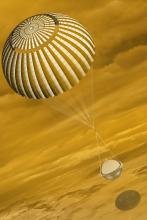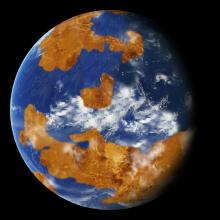Listen to today's episode of StarDate on the web the same day it airs in high-quality streaming audio without any extra ads or announcements. Choose a $8 one-month pass, or listen every day for a year for just $30.
You are here
Venus and Gemini
The surface of the planet Venus may move. It’s not like the surface of Earth, where the crust is made of thin “plates” that slide past and over each other. But there’s evidence that big chunks of Venus’s crust are moving.
Until recently, the consensus has been that Venus has a solid crust — a single structure that wraps around the planet like the skin of an apple.
But a team of geologists recently took a closer look at Venus’s surface. The team used maps compiled from observations made by an orbiting spacecraft, which peered through Venus’s unbroken cloud cover with radar.
The scientists found that blocks of the crust appear to have moved — they’ve slipped sideways, twisted to the side, or even turned around. These blocks are typically bounded by ridges or canyons that can be tens of miles wide and hundreds of miles long.
The researchers suggested that parts of the crust might be pushed and turned by motions in the layer of molten rock below the crust. That makes Venus’s surface a lot more active than scientists had thought — a surface that’s on the move.
And Venus itself is on the move, too. Our closest planetary neighbor is climbing a little higher into the evening sky each night. Tonight, the brilliant “evening star” lines up with the twins of Gemini. The stars are to the right of Venus. The brighter star, Pollux, is closer to Venus, with Castor farther along the same line.
Tomorrow: What’s the matter with dark matter?






